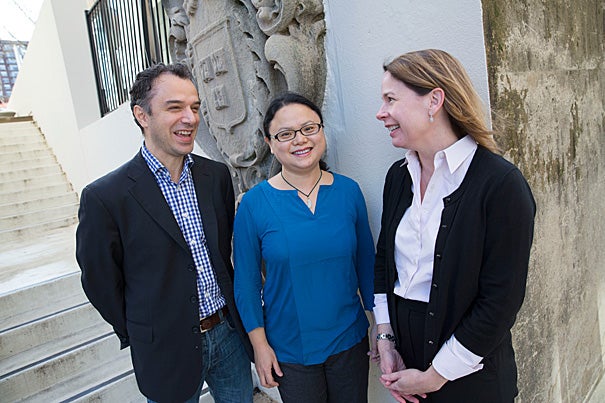
Junior Harvard faculty members Giuseppe Intini (from left), Yanmei Tie, and Mary Beth Son are among a number of recipients of a unique fellowship that aims to help budding scientists, already wrestling with knotty scientific problems, also navigate life’s complexities.
Kris Snibbe/Harvard Staff Photographer
Help with ‘the best things in life’
Shore Fellowships give junior faculty a hand juggling busy lives
Before operating on your brain, a neurosurgeon wants to know where the most important bits are. That’s where Yanmei Tie is trying to help.
Tie, an instructor in neurosurgery at Harvard Medical School (HMS) and a researcher at Harvard-affiliated Brigham and Women’s Hospital, is working on new imaging techniques to map brain regions important to language processing.
But Tie confesses she needs some help of her own these days, to manage not just her research, but the multiple, sometimes conflicting demands of research, motherhood, and aging parents.
Tie is among 86 HMS junior faculty members who received a unique fellowship that aims to help budding scientists, already wrestling with knotty scientific problems, also navigate life’s complexities.
The Eleanor and Miles Shore 50th Anniversary Fellowship Program for Scholars in Medicine was established in 1995 to celebrate the 50th anniversary of the admission of women to HMS. It offers fellowships of between $30,000 and $50,000 to help junior faculty members of both genders navigate the demands of a time in life where launching a research career demands long hours even as many of them have young families with pressing child care demands. In addition, some have academic and clinical duties added to the balancing act.
“This fellowship is really important for continuing my work. It came at a very pivotal time,” Tie said.
In Tie’s case, the fellowship is allowing her to hire a research assistant to help with preliminary data acquisition and analysis for work she’s doing with functional magnetic resonance imaging (fMRI).
The work aims to highlight the brain’s language centers — key areas to avoid damaging — for neurosurgeons before surgery. Typically, this imaging is done by having patients do certain tasks while in the fMRI machine and watching which centers of the brain become active. But because some patients have impairments that make those tasks difficult, Tie is developing “task-free” fMRI techniques to highlight language function, such as comes into play when the subjects watch a movie. Key brain regions light up for processing dialogue even if the patient isn’t speaking.
Like many researchers at a similar stage of their careers, Tie is also juggling the demands of her home life, as the primary breadwinner and mother to a 10-year-old daughter, and life back in her native China, where her elderly parents are ailing.
“To be successful in both my personal life and my career is my goal,” Tie said.
That goal is echoed by other fellowship recipients, like Giuseppe Intini, an assistant professor at the Harvard School of Dental Medicine. Intini came to Harvard for a fellowship after receiving his Ph.D. in 2007. He was named assistant professor in 2012 and has been working to investigate a kind of stem cell, a skeletal progenitor cell, in the craniofacial bones as a way to further reconstructive surgery.
Intini, whose wife teaches at Northeastern University and who has a 9-month-old infant and 3-month-old toddler, said the fellowship will allow him to hire a postdoctoral fellow to help in the lab.
“It’s a great help. Whoever conceived this knew what they were doing,” Intini said.
Mary Beth Son, an instructor in pediatrics at HMS and at Harvard-affiliated Boston Children’s Hospital, agreed.
Son, a pediatric rheumatologist who works with children with the autoimmune disorder lupus, is juggling her clinical and research work while raising three daughters, ages 6, 8, and 10.
Son is using the fellowship to reduce her clinical hours while she analyzes data from research examining the important transition of juvenile lupus patients from pediatric lupus specialists to adult physicians. She has also used some of the fellowship to hire a statistician to help analyze findings from a survey and from focus groups of patients who have already gone through the transition and are now being seen at Brigham and Women’s Hospital Lupus Center.
“I really think they acknowledge that junior faculty have different pressures on them,” Son said of the fellowship’s organizers. “We’re moving on our career path and have responsibilities at home, which are the best things in life.”




